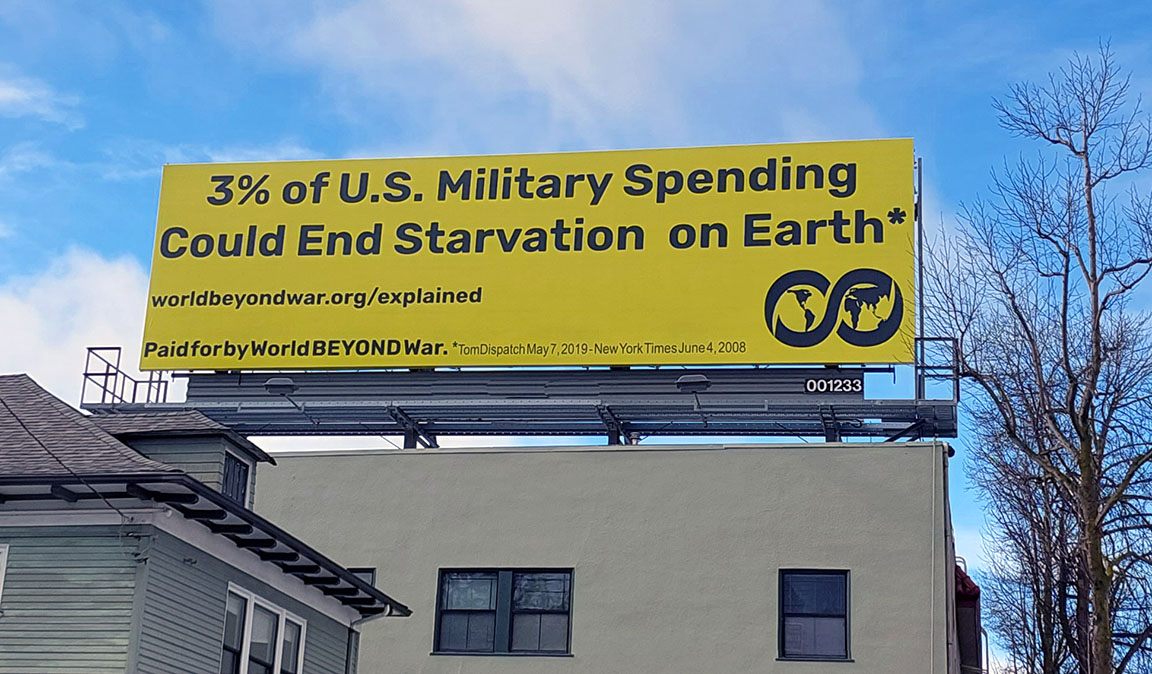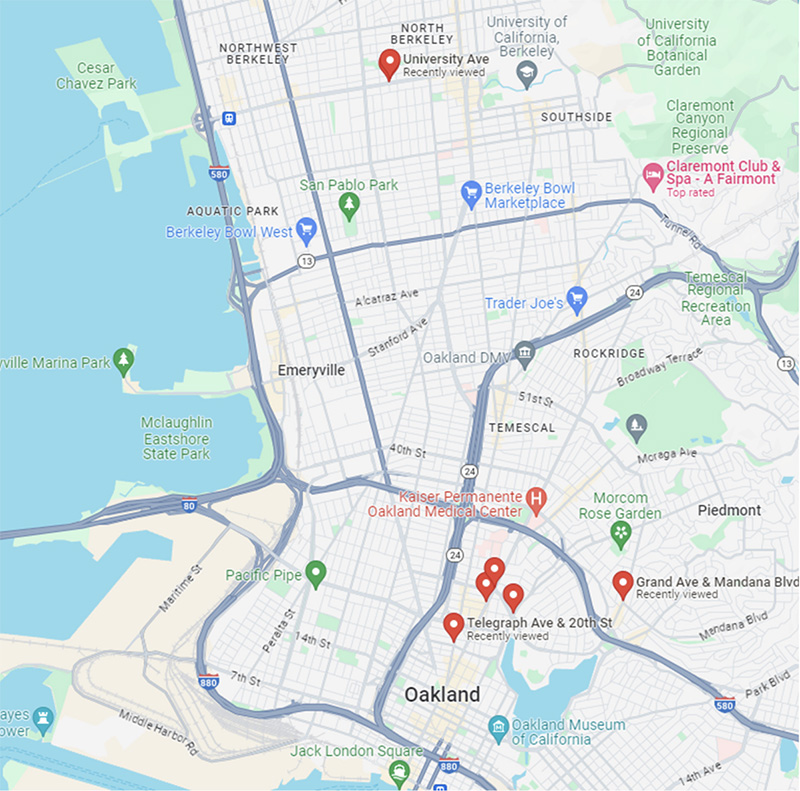
About the Billboards
Six billboards went up for a month on January 22 — five in Oakland and one in Berkeley, California.
The billboards carry in bold black text on a yellow background the words “3% of U.S. Military Spending Could End Starvation on Earth” and include a website address that explains where that statistic comes from: worldbeyondwar.org/explained.
The billboards are being put up by the global antiwar and pro-peace organization World BEYOND War, which thanks Ben Cohen, co-founder of Ben & Jerry’s for a generous donation.
This is part of World BEYOND War’s ongoing billboards project, which exists because of the small donations of many people.
They are up in these locations:
Why Do This
The main purpose is educational. A trillion dollars is not a concept one can easily visualize, but it is a very conservative underestimate of what the U.S. government spends each year on the military, including the Pentagon base budget, plus war budget, plus nuclear weapons in the Department of Energy, plus the Department of Homeland Security, and other military spending. This does not include various additional spending bills, such as those now under consideration to put over $100 billion into more weapons for Ukraine, Israel, Taiwan, and the border of Mexico.
Three percent of a trillion dollars, or $30 billion, is still not easy to visualize, but it could end starvation everywhere, or hire 33 thousand teachers at $90,000 each, or provide 3 million units of public housing at $10,000 each, or provide 60 million households with wind power at $500 each. And those alternatives would not only benefit huge numbers of people, but also have greater positive economic impact. Far from being the jobs program often claimed, military spending produces fewer jobs than other public spending, and fewer jobs than never taxing the money from working people at all.
The events being planned will be fundraisers for Food Not Bombs, which provides food to those in need locally.
Further thoughts on this topic from David Swanson:
The 2020 Democratic Party Platform said that Democrats would reduce military spending: “We can maintain a strong defense and protect our safety and security for less.” Right on! Get out the vote!
Then a Democratic president proposed an increase each of the next three years, just as his Republic predecessor had done each year. And Congress not only went along but went over and above the proposed increases, with more bipartisan harmony than we are usually led to believe exists.
Congress is having a remarkably difficult time deciding whether to put an extra $100 billion or so into more weapons for Ukraine, Israel, Taiwan, and the border of Mexico, with various groups of Congress Members opposing one or another of those expenditures, and the combining of them failing thus far to win passage.
But the military spending Congress does agree on year after year is so vast as to be beyond easy visualization or comprehension. The U.S. government spends well over $1 trillion each year on its military. A 2019 article from a Quincy Institute author at TomDispatch identifies costs of $1.25 trillion. This includes the annual Pentagon base budget, plus war budget, plus nuclear weapons in the Department of Energy, plus the Department of Homeland Security, and other military spending.
Military spending is over half of federal discretionary spending — the money Congress decides how to spend each year (so, not including spending mandated over many years, such as much of Social Security or Medicare). And yet it is extremely rare for a candidate for Congress to have any position at all on military spending or the general outline of the federal budget, and even rarer for a media outlet to ask them for one. One reason this is odd is that a tiny fraction of military spending, if diverted elsewhere, could radically transform just about any of the policy areas that candidates do have positions on.
My organization, World BEYOND War, has put up six billboards in Berkeley and Oakland that each say in big black letters on a yellow background “3% of U.S. Military Spending Could End Starvation on Earth.”
The 3% figure comes from dividing what the United Nations says it would cost to end starvation globally by what the U.S. government spends on its military each year.
In 2008, the United Nations said that $30 billion per year could end starvation on Earth. The Food and Agriculture Organization of the United Nations tells us that number is still up to date.
This does not factor in the dramatic increase in the past few months of people facing starvation, 80% of whom worldwide are now in Gaza. But clearly the most important first step to help them would be to cease putting billion of dollars into weapons for the war.
Starvation is not the only thing you could address with $30 billion a year (or $600 billion over the past 20 years). For $30 billion a year, you could hire 33 thousand teachers at $90,000 each, or provide 3 million units of public housing at $10,000 each, or provide 60 million households with wind power at $500 each. Can you imagine if we valued education or housing or the sustainability of life on Earth that much?
Those alternatives would not only benefit huge numbers of people directly. They would also have greater positive economic impact than military spending does. Far from being the jobs program often claimed, military spending produces fewer jobs than other public spending, and fewer jobs than never taxing the money from working people at all. It may sound grotesquely sociopathic to defend war as a jobs progam, but it’s also just plain false, as military spending actually eliminates jobs.
U.S. military spending dwarfs the cost of most infrastructure and social needs spending legislation, the cost of any other item (or dozen items) of federal discretionary spending, and the military spending of any other nation. Of 230 other countries, the U.S. spends more on militarism than 227 of them combined. In 2022 military spending per capita, the U.S. government trailed only Qatar and Israel. All of the top 27 nations in per capita military spending are U.S. weapons customers.
The U.S. pressures other nations to spend more. Of 230 other countries, the U.S. exports more weaponry than 228 of them combined. Much of Donald Trump’s opposition to NATO, between 2017 and 2020, amounted to badgering NATO members to spend more on militarism. (With enemies like these, who needs boosters?)
Check out these basic military spending numbers — in the year 2022 and measured in 2022 U.S. dollars, from SIPRI (so, leaving out a huge chunk of U.S. spending):
- Total $2,209 billion
- U.S. $877 billion
- All countries on Earth but U.S., Russia, China, and India $872 billion
- NATO members $1,238 billion
- NATO “partners across the globe” $153 billion
- NATO Istanbul Cooperation Initiative $25 billion (no data from UAE)
- NATO Mediterranean Dialogue $46 billion
- NATO Partners for Peace excluding Russia and including Sweden $71 billion
- All NATO combined excluding Russia $1,533 billion
- Entire Non-NATO world including Russia (no data from North Korea) $676 billion (44% of NATO and friends)
- Russia $86 billion (9.8% of U.S.)
- China $292 billion (33.3% of U.S.)
- Iran $7 billion (0.8% of U.S.)
The U.S. public has tended for decades to be less supportive of enormous military spending than elected officials, but also to have very little grasp of how much it is or how it compares to other things. Since almost nobody can tell you what exactly a trillion dollars in military spending buys, it follows that almost nobody can tell you why $970 billion wouldn’t be just as good or better. The Pentagon, the one department that has never passed an audit, cannot answer such questions itself.
So, regardless of your belief, or lack thereof, in the wisdom of militarism in general, you are asked to take it on faith that something better than ending starvation is being done with the last little bit of the military budget. Where is our usual skepticism? We need it badly!
Listen to this topic discussed on Rising Up with Sonali, and on Flashpoints.
David Swanson is executive director of World BEYOND War. He will be in Berkeley and Oakland on January 28 for events related to six billboards put up by his organization.
Media Coverage
Audio from Flashpoints on KPFA
(Second half of the program)__________________________
__________________________
Announcement on IndyBay.org.
__________________________
__________________________

Raising Public Awareness of U.S. Military Spending
Listen here.__________________________
__________________________
On KPFA with Kris Welch
About the Event in Oakland
UPDATE: This event happened on January 28, 2024.
Events are being planned in partnership with CODEPINK and other organizations. There will be a colorful ribbon-cutting ceremony at 2:00 p.m. on Sunday, January 28th, in front of the First Congregational Church of Oakland at 2501 Harrison St, Oakland, CA 94612, which is just across an intersection from one of the billboards. This will be followed by a reception inside the church from 2:30 – 3:30 p.m. with speakers, music, and food.
Among those taking part will be:
David Swanson, Executive Director of World BEYOND War
Keith McHenry, Founder of Food Not Bombs
Francisco Hererra, musician
John Lindsay-Poland, American Friends Service Committee
Paul Cox, Veterans For Peace
Cynthia Papermaster, CODEPINK S.F. Bay Area
Jackie Cabasso, Western States Legal Foundation
Jim Haber, War Tax Resistance
David Hartsough, Co-Founder of World BEYOND War
Nell Myhand, Poor Peoples Campaign
Dennis Bernstein, KPFA “Flashpoints”
Joel Eis, former organizer of National Draft Resistance, member of El Teatro Campesino
Hassan Fouda, NorCal Sabeel
Hali Hammer
Occupella
David Vine, author of The United States of War
Michelle Vong, Oakland Youth Poet Vice Laureate
Ann Fagan Ginger, Founder, Meiklejohn Civil Liberties Institute
Avotcja, radio host
Joanna Macy, author, ecophilosopher, buddhist scholar and anti-nuclear activist
Kathleen Sullivan, PhD, disarmament educator, activist and producer
Dolores Perez Heilbron, SF Unitarian Universalists Social Justice Committee
Event Endorsed By
World BEYOND War
CODEPINK Women for Peace SF Bay Area
Food Not Bombs
Extinction Rebellion Peace
Veterans For Peace
Berkeley No More Guantanamos
Western States Legal Foundation
Meiklejohn Civil Liberties Institute
Berkeley Fellowship of Unitarian Universalists Social Justice Committee
Environmentalists Against War
RootsAction.org
Women’s International League for Peace and Freedom, East Bay and San Francisco
UNAC
San Luis Obispo Mothers for Peace
Triple Justice
Poor Peoples Campaign
The San Francisco Friends Meeting Peace Committee
Anti-Police Terror Project
Haiti Action Committee
Task Force on the Americas
San Mateo Peace Action
Wellstone Democratic Renewal Club
Parking
If you have to bring a car, there is parking in the church parking lot for a limited number of cars (20 or so) and there’s also street parking nearby. We should not park in the Sogorea Te Land Trust or the school spaces adjacent to the church.
Flyers
Contact Us
Questions or Suggestions
Photos of the Billboards
Send us your photos and we’ll add them here.











